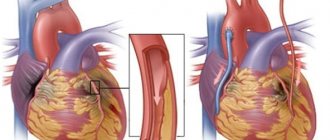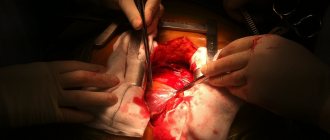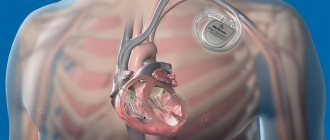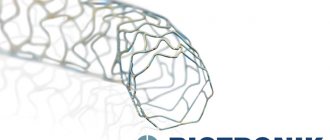Indications
CABG is an operation that is primarily required for patients with severe angina that is resistant to drug therapy. In addition, surgical treatment may be recommended in the absence of symptoms. There is silent myocardial ischemia, which is no less dangerous. It is not felt by the patient, but can be diagnosed using ECG and Holter monitoring.
Indications for CABG can also be determined using coronary angiography. This is an x-ray test in which contrast is injected into the arteries of the heart. The main cause of mortality from coronary disease is atherosclerosis and disruption of the integrity of the atherosclerotic plaque. The blood vessel is torn, and a blood clot forms at the site of damage. It clogs the coronary artery, resulting in myocardial infarction.
Coronary angiography allows you to identify large obstacles to blood flow (atherosclerotic plaques) and assess the risk of acute cardiovascular events. A high degree of coronary artery disease requires cardiac CABG.
Based on the results of coronary angiography, the main indications for CABG are:
- Narrowing of the lumen of any coronary artery by 75% or more
- Reduction in the lumen of the left coronary artery trunk by 50% or more
The location of stenosis (impaired patency) of the coronary arteries is also assessed. The more proximal it is (closer to the heart), the worse the blood supply to the myocardium. CABG surgery on the heart will be most successful if normal blood circulation is observed beyond the narrowing.
Contraindications
Coronary artery bypass grafting (CABG) may not be performed on patients even if there are indications for surgery. This may be due to the presence of contraindications. These are diseases and conditions of the body that make surgery too dangerous or unsuccessful.
Main contraindications for cardiac CABG:
- Reduced left ventricular ejection fraction by up to 30%
- Congestive heart failure
- Impaired blood flow in all coronary arteries
- Severe concomitant diseases
In case of circulatory disorders in all coronary arteries, preference is given to laser myocardial revascularization or cell therapy.
results
After 6 months after CABG, 94% of patients took statins, 91% - beta-blockers, 73% - blockers of the renin-angiotensin-aldosterone system and 93% - antiplatelet drugs, and after 8 years the number of patients in these categories was 77%, 76%, 66%, 80 %, respectively.
Cox regression was used to assess the effectiveness of the studied drug groups in reducing the risk of death. Before adjusting for the use of other secondary prevention drugs in the model, use of all groups was associated with a reduced risk of death from all causes, but after this adjustment, the association between taking beta-blockers and a reduction in the risk of death from all causes became insignificant: relative risk 0.97; 95% confidence interval 0.90-1.06; p=0.54.
How is the operation performed?
The operation can be performed using a heart-lung machine. In addition, in developed countries, including Germany, off-pump CABG is increasingly being used.
The essence of surgery is to create a bypass path for blood flow. For this purpose, shunts are created - additional vessels that leave the aorta and flow into the coronary arteries - beyond the level of narrowing. A person’s own veins or arteries are used as prostheses. This may be the great saphenous vein or the radial artery.
Usually 3 bypasses are created - for the largest coronary arteries:
- Anterior interventricular
- Envelope
- Right
In 20% of patients, 4-8 anastomoses are installed. More preferable is CABG (coronary artery bypass grafting) on a beating heart.
The advantages are as follows:
- Blood cells are not damaged
- Rehabilitation after CABG is faster
- The operation has a shorter duration
In this case, complications after CABG on the heart are less common. Because there is no risk from those that are directly related to the use of a heart-lung machine. This is pulmonary edema, embolic damage to the blood vessels of the brain or kidneys, hypoxia (oxygen starvation) of internal organs.
Conclusion
Life after coronary artery bypass surgery does not end, but only begins. For many people, this intervention helps them quit smoking and start a healthy lifestyle. There is no need to consider yourself disabled, you still have a long way to go, many patients even manage to achieve good results in sports after performing this operation.
ATTENTION!
All materials on the site (including video and audio clips on third-party resources) are for educational and informational purposes only. There are contraindications. Before using recommendations and advice from the site and videos, ALWAYS consult your doctor! All patient names used in articles on this site have been changed for ethical reasons. Any similarities are random.
Recovery after coronary artery bypass surgery
Immediately after surgery, the patient is on artificial ventilation for a certain time. And after natural breathing is restored, prevention of congestion is required. To do this, the patient is asked to inflate rubber balls several dozen times a day. As a result, the lungs expand.
Recovery from open-heart CABG involves caring for the surgical wound. The incision is made down the middle of the sternum. In addition, there is damage to the lower extremities - where the doctor took the material for bypass (the great saphenous vein). Skin wounds heal in 1-2 weeks. After this, the person is allowed to wash in the shower.
Banding after CABG is not mandatory, but is preferred to reduce the risk of sternal suture dehiscence. While skin heals in an average of 10 days, bone heals over several months. Patients often ask how long to wear a bandage after CABG. It is usually used for 4-6 months.
There should be no arrhythmia after CABG. If it occurs, it is not a consequence of the operation. There are a large number of arrhythmias. Some may be caused by myocardial ischemia, others by independent pathologies, and still others by previous myocardial infarction. Typically, the heart rhythm normalizes after surgery due to improved blood supply to the heart muscle.
The consequences of CABG surgery are assessed 2-3 months after it is performed. By this time, angina should no longer bother the patient. The person is given a stress test and IVF is removed to understand how much the blood supply to the myocardium has improved. If there is no pain after CABG during physical activity, the operation is considered successful.
Recovery after CABG can be carried out in a clinic, in a sanatorium or at home. Naturally, the most successful rehabilitation will be under the guidance of a specialist. But some patients undergo rehabilitation after CABG at home, which is usually associated with a desire to save money. If there is no money for quality restoration, you need to take care of yourself. Exercise after CABG surgery is very important. You need to start with walking - at least 1 kilometer a day. Then - gradually increase the load.
Patients often ask when they can sleep on their side after CABG. You can lie on your side almost immediately, if that’s comfortable for you. Most doctors do not prohibit this from happening to their patients, since sleeping on the side does not affect the results of the operation.
Send a request for treatment
Life after CABG on the heart
After CABG, a person’s life changes only for the better. Full recovery takes about 6 months. During this time, the sternum grows together and tolerance to physical activity increases. Disability after CABG is not issued. Moreover, disability after CABG can be removed if you become able-bodied again. And if the operation is successful and there is no concomitant pathology, this will happen.
Several important questions that patients often ask regarding lifestyle after surgery:
- Showering - allowed 10 days after surgery (plus or minus 2 days) if the skin wound has healed
- A bath after cardiac CABG is allowed after 2-3 months, when you undergo a follow-up examination (because temperature changes can provoke spasm of the coronary arteries and an attack of angina)
- Alcohol after CABG is allowed in moderation after the early postoperative recovery period
- Smoking is prohibited because it leads to narrowing of the coronary vessels and increases the risk of atherosclerotic damage.
- Gymnastics after CABG - carried out under the guidance of a specialist in physical therapy, required to strengthen the heart muscle and improve tolerance to physical activity
- Diet after coronary artery bypass grafting is desirable, but not mandatory (you can reduce the consumption of animal fats to reduce the risk of atherosclerotic plaques in places where they do not yet exist)
Having surgery does not guarantee that you will not have angina or myocardial infarction in the future. Because CABG only allows you to bypass narrowed areas of blood vessels. But after a few years, new atherosclerotic plaques may appear. Therefore, it is important to adhere to a healthy lifestyle and take medications prescribed by your doctor.
Doctor Shishonin's opinion
Alexander Yurievich notes that CABG is a serious injury to the body. To recover faster, a person needs energy, that is, he must eat right. In your diet, you need to increase the level of high-quality animal fats (chicken eggs, milk, cottage cheese, sour cream). They help build up lost cell mass.
It is known that biological cell membranes mainly consist of fats (phospholipids and cholesterol) - these are extremely necessary substances for rapid rehabilitation in the postoperative period.
At the first stage of postoperative rehabilitation, even in the cardiac surgery clinic, movement is very important for the patient. When a person is very weak, special gymnastics can be performed even in bed. In no case should you adhere to tactics - “I am very weak”, “I need rest”, etc. You must constantly train yourself. After all, it has long been known that movement is life.
Additional Information.
In leading European and Russian clinics, during the postoperative period, patients are forced to walk at least 1000 meters per day. After CABG, a person has a good blood supply to the heart, so the risk of developing problems with the functioning of the cardiovascular system is minimal. Competent cardio exercises will allow the patient to overcome 5 and even 10 km after some time.
Join the Club of Former Hypertensive Patients
.
- Download gymnastics, which has already helped hundreds of thousands of people overcome blood pressure surges and hypertension.
- Get the most current and reliable information about problems related to blood pressure, osteochondrosis and atherosclerosis.
- Ask your questions to Dr. Shishonin and just chat.
Where is the best place to do CABG?
Coronary artery bypass surgery is performed all over the world. Many residents of the CIS undergo CABG in Moscow. Often, residents of developing countries seek to travel abroad for surgery. Because it is very dangerous and requires a long recovery. A better-quality operation provides better treatment results and a less painful rehabilitation period.
Residents of many countries go to the States for CABG surgery. The medicine there is really high quality, but very expensive. It is cheaper to do CABG in Israel. We recommend Germany. This is the “golden mean” - German clinics are able to provide the same high quality of medical services as the United States, but it is easier to come here for treatment, and the services of doctors are cheaper.
The main advantages of coronary artery bypass surgery in Germany:
- Surgery is performed on a beating heart if possible given the clinical situation
- The best doctors work in Germany - they come here from all over the world to practice medicine. And when performing CABG, the qualifications of the cardiac surgeon play a significant role
- German clinics are equipped with the latest technology
- After the operation, the person is provided with high-quality care and medicinal support, which improves the tolerability of the early postoperative period
- The opportunity to undergo high-quality rehabilitation, which will return a person to his former lifestyle and restore his ability to work
Safe and effective aortic surgery can be performed at the Helios Klinik Krefeld, a medical center of maximum care, continuously collaborating with leading universities and research centers around the world. The Department of Adult and Pediatric Cardiac Surgery, under the direction of Prof. Dr. med. Jürgen Ennker, has a number of its own developments in the field of surgical interventions on the thoracic and abdominal aorta. These are coronary artery bypass grafting using minimal extracorporeal circulation (a special heart-lung machine is used), coronary artery bypass grafting on a beating heart, and minimally invasive direct coronary artery bypass grafting. The department also uses hybrid endoprostheses of the thoracic and abdominal aorta, and performs classical reconstructive interventions with the installation of self-expanding stents. At the same time, the department’s specialists perform both primary and more complex revision interventions on patients of all ages.
Treatment in Germany can be organized for you by ]Booking Health[/anchor]. We have been working in the medical tourism market for a long time, so we can choose the best clinic for you. You will be treated by the most reputable German specialists.
Thanks to our help, you can save up to 70% of the total costs of treatment and its organization. We have direct contracts with all major clinics in Germany. For treatment you do not have to take out insurance for foreign patients. You will receive Booking Health insurance, which will cover all unexpected medical expenses during the treatment period and for 4 years after it.










